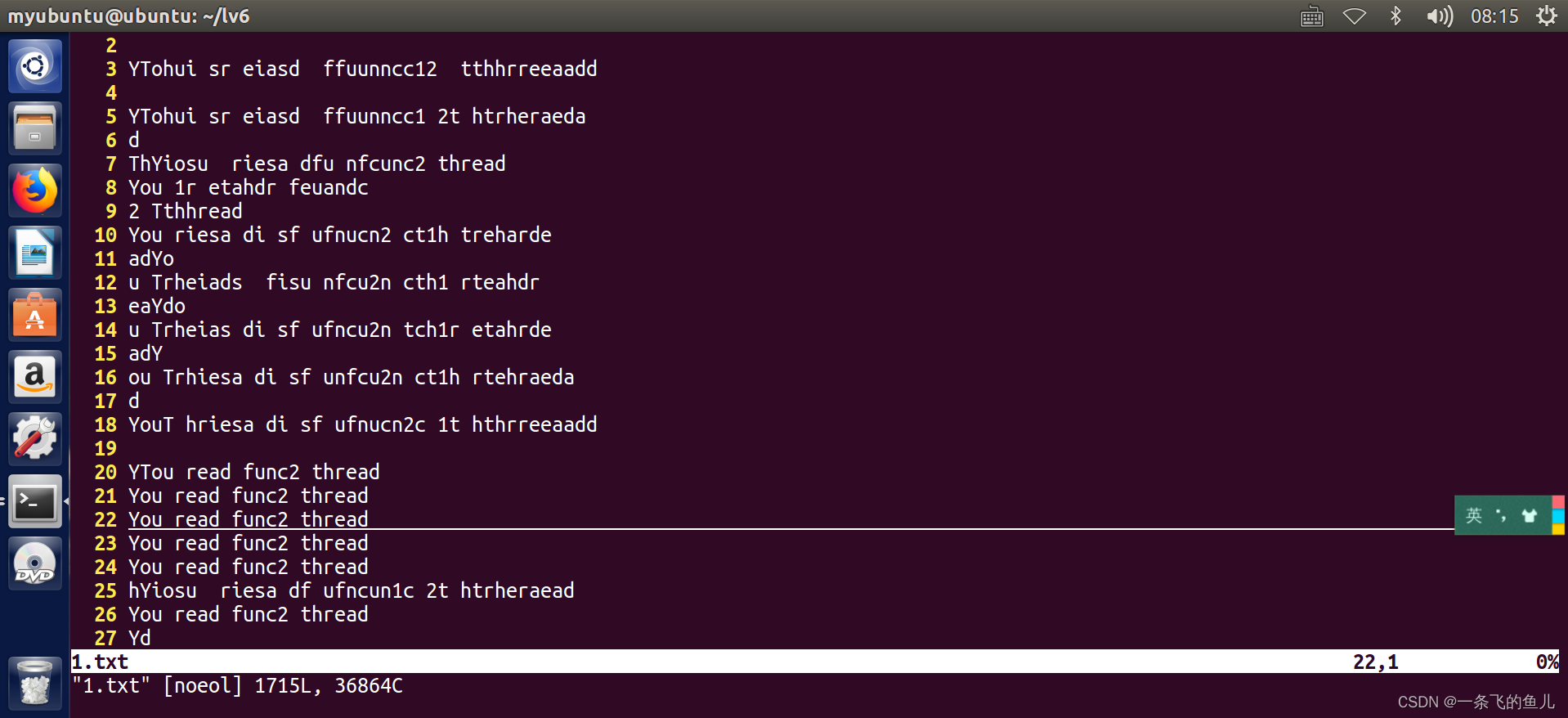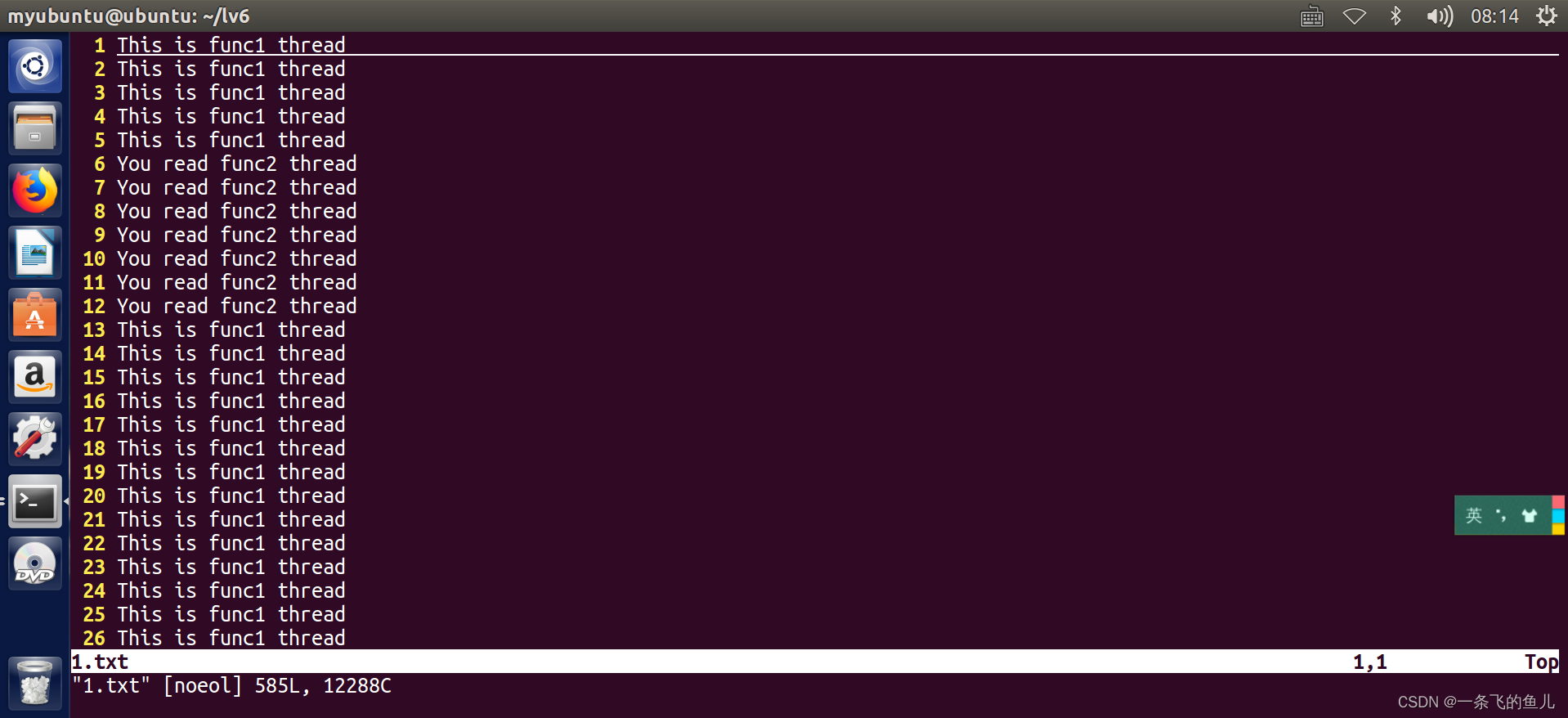目录
一、线程的创建和参数传递
1. 线程的创建
#include <pthread.h>
int pthread_create(pthread_t *thread, constpthread_attr_t *attr,
void *(*routine)(void *), void *arg);
成功返回0,失败时返回错误码
thread 线程对象
attr 线程属性,NULL代表默认属性
routine 线程执行的函数
arg 传递给routine的参数 ,参数是void * ,注意传递参数格式,
编译错误分析:
1.
createP_t.c:14:36: warning: passing argument 3 of ‘pthread_create’ from incompatible pointer type [-Wincompatible-pointer-types]
ret = pthread_create(&tid,NULL,testThread,NULL);
^
In file included from createP_t.c:1:0:
/usr/include/pthread.h:233:12: note: expected ‘void * (*)(void *)’ but argument is of type ‘int * (*)(char *)’
意义:表示pthread_create参数3的定义和实际代码不符合,期望的是void * (*)(void ) ,实际的代码是int * ()(char )
解决方法:改为pthread_create(&tid,NULL,(void)testThread,NULL);
createP_t.c:(.text+0x4b):对‘pthread_create’未定义的引用
collect2: error: ld returned 1 exit status --------这个链接错误,
表示pthread_create这个函数没有实现
解决方法:编译时候加 -lpthread
注意事项:1. 主进程的退出,它创建的线程也会退出。
线程创建需要时间,如果主进程马上退出,那线程不能得到执行
获取线程的id
通过pthread_create函数的第一个参数;通过在线程里面调用pthread_self函数
3. 线程结束 – pthread_exit
#include <pthread.h>
void pthread_exit(void *retval);
结束当前线程
retval可被其他线程通过pthread_join获取
线程私有资源被释放
4. 线程查看tid函数
– #include <pthread.h>
– pthread_t pthread_self(void); 查看自己的TID
5. 线程间参数传递:(重点难点)
pthread_create(pthread_t *thread, const
pthread_attr_t *attr, void *(*routine)(void *), void *arg);
编译错误:
createP_t.c:8:34: warning: dereferencing ‘void *’ pointer
printf("input arg=%d\n",(int)*arg);
^
createP_t.c:8:5: error: invalid use of void expression
printf("input arg=%d\n",(int)*arg);
错误原因是void 类型指针不能直接用取值(arg),因为编译不知道数据类型。
解决方法:转换为指定的指针类型后再用取值 比如:*(int *)arg
- 通过地址传递参数,注意类型的转换
- 值传递,这时候编译器会告警,需要程序员自己保证数据长度正确
运行错误:
*** stack smashing detected ***: ./mthread_t terminated
已放弃 (核心已转储)
原因:栈被破坏了(数组越界)
例子:
#include <stdio.h>
#include <unistd.h>
#include <stdlib.h>
#include <pthread.h>
void *testThread(void *arg) {
printf("This is test pid = %d, tid = %lu\n", getpid(), pthread_self());
printf("This %d pthread\n", *(int *)arg);
pthread_exit(NULL);//结束线程
}
int main () {
pthread_t tid[5];
int ret;
int i;
for (i = 0; i < 5; i++) {//创建五个线程
ret = pthread_create(&tid[i], NULL, testThread, (void *)i);
sleep(1);
printf("This is main pthread, the %d tid = %lu\n", i, tid[i]);
}
return 0;
}
二、线程的回收
1. 线程回收 pthread_join
#include <pthread.h>
int pthread_join(pthread_t thread, void **retval);
对于一个默认属性的线程 A 来说,线程占用的资源并不会因为执行结束而得到释放
成功返回0,失败时返回错误码
thread 要回收的线程对象
调用线程阻塞直到thread结束
*retval 接收线程thread的返回值
注意:pthread_join 是阻塞函数,如果回收的线程没有结束,则一直等待
编译错误:
pjoin.c:13:5: error: unknown type name ‘pthead_t’
pthead_t tid;
错误类型:未知的类型pthead_t
错误可能:1拼写错误,2对应的头文件没有包含
pjoin.c:18:12: warning: format ‘%s’ expects argument of type ‘char *’, but argument 2 has type ‘void *’ [-Wformat=]
printf("thread ret=%s\n",retv);
错误类型:参数不匹配,期望的是char * ,但参数retv是void *
解决:在参数前面加强制类型转换(char*)retv
例子:
#include <stdio.h>
#include <pthread.h>
void *func(void *arg) {
printf("This is child thread the %d\n", *(int *)arg);
sleep(1);
pthread_exit("thread return ");
}
int main () {
pthread_t tid[5];
void * retv;
int i;
for (i = 0; i < 5; i++) {//创建线程
pthread_create(&tid[5], NULL, func, (void *)&i);
}
for (i = 0; i < 5; i++) {//回收线程一个一个的回收
pthread_join(tid[i], &retv);
printf("thread retv = %s\n", (char *)retv);
}
sleep(1);
}
2. 线程分离 pthead_detach
int pthread_detach(pthread_t thread);
成功:0;失败:错误号
– 指定该状态,线程主动与主控线程断开关系。线程结束后(不会产生僵尸线程)
pthread_attr_t attr; /*通过线程属性来设置游离态(分离态)*/
例子:
#include <stdio.h>
#include <pthread.h>
void *func(void *arg) {
pthread_detach(pthread_self());
printf("This is child thread\n");
sleep(25);
pthread_exit("thread return ");
}
int main () {
pthread_t tid[5];
int i;
for (i = 0; i < 5; i++) {
pthread_create(&tid[5], NULL, func, NULL);
// pthread_detach(tid);
}
while(1) {
sleep(1);
}
}
3. 线程的分离 pthread_attr_init
• 设置线程属性为分离
• pthread_attr_init(&attr);
• pthread_attr_setdetachstate(&attr, PTHREAD_CREATE_DETACHED);
使用线程的分离:
两种方式:
1 使用pthread_detach
2 创建线程时候设置为分离属性
pthread_attr_t attr;
pthread_attr_init(&attr);
pthread_attr_setdetachstate(&attr,PTHREAD_CREATE_DETACHED);
例子:
#include <stdio.h>
#include <pthread.h>
void *func(void *arg) {
printf("This is child thread\n");
sleep(1);
pthread_exit("thread return ");
}
int main () {
pthread_t tid[5];
void * retv;
int i;
pthread_attr_t attr;
pthread_attr_init(&attr);
pthread_attr_setdetachstate(&attr, PTHREAD_CREATE_DETACHED);
for (i = 0; i < 5; i++) {
pthread_create(&tid[5], NULL, func, NULL);
}
while(1) {
sleep(1);
}
}
三、线程的取消
意义:随时杀掉一个线程
int pthread_cancel(pthread_t thread);
void pthread_testcancel(void); // 如果没有取消点,手动设置一个
注意:线程的取消要有取消点才可以,不是说取消就取消,线程的取消点主要是阻塞的系统调用
#include <pthread.h>
#include <stdio.h>
#include <unistd.h>
void *func(void *arg){
printf("This is child thread\n");
while(1){ //阻塞
// sleep(1); //取消点
void pthread_testcancel(void); // 如果没有取消点,手动设置一个
}
//线程的取消函数不会执行到
pthread_exit("thread return");
}
int main(){
pthread_t tid;
void *retv;
pthread_create(&tid,NULL,func,NULL); //创建线程
sleep(1);
pthread_cancel(tid); //线程的取消
pthread_join(tid,&retv);// 线程的回收
//当调用线程pthread_cancel取消函数时,线程的结束函数的返回值就不存在了
//printf("thread ret=%s\n",(char*)retv); //打印线程结束的返回值
while(1){
sleep(1);
}
}
运行段错误调试
可以使用gdb调试
使用gdb 运行代码,gdb ./youapp
(gdb) run
等待出现Thread 1 "pcancel" received signal SIGSEGV, Segmentation fault.
输入命令bt(打印调用栈)
(gdb) bt
#0 0x00007ffff783ecd0 in vfprintf () from /lib/x86_64-linux-gnu/libc.so.6
#1 0x00007ffff78458a9 in printf () from /lib/x86_64-linux-gnu/libc.so.6
#2 0x00000000004007f9 in main () at pcancel.c:21
确定段错误位置是pcancel.c 21行
设置取消使能或禁止
int pthread_setcancelstate(int state, int *oldstate);
state:
PTHREAD_CANCEL_ENABLE // 条件取消线程
PTHREAD_CANCEL_DISABLE // 禁止取消线程
#include <pthread.h>
#include <stdio.h>
#include <unistd.h>
void *func(void *arg){
printf("This is child thread\n");
pthread_setcancelstate(PTHREAD_CANCEL_DISABLE,NULL); //禁止取消线程,有又取消点也不能取消该线程
// while(1)
{
sleep(5);
pthread_testcancel();
}
pthread_setcancelstate(PTHREAD_CANCEL_ENABLE,NULL); //过五秒取消该线程
while(1){
sleep(1);
}
pthread_exit("thread return");
}
int main(){
pthread_t tid;
void *retv;
pthread_create(&tid,NULL,func,NULL); //创建线程
sleep(1);
pthread_cancel(tid); //线程的取消
pthread_join(tid,&retv);// 线程的回收
while(1){
sleep(1);
}
}
设置取消类型
int pthread_setcanceltype(int type, int *oldtype);
PTHREAD_CANCEL_DEFERRED 等到取消点才取消(默认)
PTHREAD_CANCEL_ASYNCHRONOUS 目标线程会立即取消
四、线程的清理
必要性: 当线程非正常终止,需要清理一些资源。
void pthread_cleanup_push(void (*routine) (void *), void *arg)
void pthread_cleanup_pop(int execute)
routine 函数被执行的条件:
- 被pthread_cancel取消掉。
- 执行pthread_exit
- 非0参数执行pthread_cleanup_pop()
#include <pthread.h>
#include <stdio.h>
#include <unistd.h>
void cleanup(void *arg){ //可以写一写线程取消之前的清理工作比如:malloc申请的空间没有free释放的
printf("cleanup,arg=%s\n",(char*)arg);
}
void *func(void *arg){
printf("This is child thread\n");
pthread_cleanup_push(cleanup,"abcd");//线程清理函数push
while(1)
{
sleep(1); //取消点
}
pthread_exit("thread return");
pthread_cleanup_pop(1);//线程清理函数pop
}
int main(){
pthread_t tid;
void *retv;
pthread_create(&tid,NULL,func,NULL); //创建线程
sleep(1);
pthread_cancel(tid); //线程的取消
pthread_join(tid,&retv);// 线程的回收
while(1){
sleep(1);
}
}
注意:
- 必须成对使用,即使pthread_cleanup_pop不会被执行到也必须写上,否则编译错误。
- pthread_cleanup_pop()被执行且参数为0,pthread_cleanup_push回调函数routine不会被执行.
- pthread_cleanup_push 和pthread_cleanup_pop可以写多对,routine执行顺序正好相反
- 线程内的return 可以结束线程,也可以给pthread_join返回值,但不能触发pthread_cleanup_push里面的回调函数,所以我们结束线程尽量使用pthread_exit退出线程。
五、线程的互斥和同步
临界资源概念:
不能同时访问的资源,比如写文件,只能由一个线程写,同时写会写乱。
比如外设打印机,打印的时候只能由一个程序使用。
外设基本上都是不能共享的资源。
生活中比如卫生间,同一时间只能由一个人使用。
必要性: 临界资源不可以共享
man手册找不到 pthread_mutex_xxxxxxx (提示No manual entry for pthread_mutex_xxx)的解决方法:
apt-get install manpages-posix-dev
六、互斥锁
1. 互斥锁的创建和销毁
两种方法创建互斥锁,静态方式和动态方式
(1)动态方式:
int pthread_mutex_init(pthread_mutex_t *restrict mutex,const pthread_mutexattr_t *restrict attr);
其中mutexattr用于指定互斥锁属性,如果为NULL则使用缺省属性。
(2)静态方式:
pthread_mutex_t mutex = PTHREAD_MUTEX_INITIALIZER;
(3)锁的销毁:
int pthread_mutex_destroy(pthread_mutex_t *mutex)
在Linux中,互斥锁并不占用任何资源,因此LinuxThreads中的 pthread_mutex_destroy()除了检查锁状态以外(锁定状态则返回EBUSY)没有其他动作。
2. 互斥锁的使用:
int pthread_mutex_lock(pthread_mutex_t *mutex)
int pthread_mutex_unlock(pthread_mutex_t *mutex)
int pthread_mutex_trylock(pthread_mutex_t *mutex)
vim 设置代码全文格式化:gg=G
例子:
#include <stdio.h>
#include <string.h>
#include <pthread.h>
pthread_mutex_t mutex = PTHREAD_MUTEX_INITIALIZER;
FILE *fp;
void *read_func1(void *arg) {
pthread_detach(pthread_self());
printf("%d, This read_func1 thread. \n", (int )arg);
char str[] = "This is func1\n";
char c;
int i = 0;
while(1) {
pthread_mutex_lock(&mutex);
while(i < strlen(str) ){
c = str[i];
fputc(c,fp);
i++;
usleep(1);
}
pthread_mutex_unlock(&mutex);
i = 0;
usleep(1);
}
pthread_exit("read_func1 thread");
}
int main() {
pthread_t tid1;
fp = fopen("1.txt", "a+");
if (fp == NULL) {
perror("fopen");
return 0;
}
pthread_create(&tid1, NULL, read_func1, 1);
while(1) {
sleep(1);
}
return 0;
}
结果:不加锁的 很乱没有规律

结果:加了锁的

七、读写锁
必要性:提高线程执行效率
特性:
写者:写者使用写锁,如果当前没有读者,也没有其他写者,写者立即获得写锁;否则写者将等待,直到没有读者和写者。
读者:读者使用读锁,如果当前没有写者,读者立即获得读锁;否则读者等待,直到没有写者。
注意:
同一时刻只有一个线程可以获得写锁,同一时刻可以有多个线程获得读锁。
读写锁出于写锁状态时,所有试图对读写锁加锁的线程,不管是读者试图加读锁,还是写者试图加写锁,都会被阻塞。
读写锁处于读锁状态时,有写者试图加写锁时,之后的其他线程的读锁请求会被阻塞,以避免写者长时间的不写锁
初始化一个读写锁 pthread_rwlock_init
读锁定读写锁 pthread_rwlock_rdlock
非阻塞读锁定 pthread_rwlock_tryrdlock
写锁定读写锁 pthread_rwlock_wrlock
非阻塞写锁定 pthread_rwlock_trywrlock
解锁读写锁 pthread_rwlock_unlock
释放读写锁 pthread_rwlock_destroy
#include <pthread.h>
#include <stdio.h>
#include <unistd.h>
#include <string.h>
pthread_rwlock_t rwlock;
FILE *fp;
void * read_func(void *arg){
pthread_detach(pthread_self());
printf("read thread\n");
char buf[32]={0};
while(1){
pthread_rwlock_rdlock(&rwlock); //创建读锁
while(fgets(buf,32,fp)!=NULL){
printf("%d,rd=%s\n",(int)arg,buf);
usleep(1000);
}
pthread_rwlock_unlock(&rwlock);//解锁读锁
sleep(1);
}
}
void *func2(void *arg){
pthread_detach(pthread_self());
printf("This func2 thread\n");
char str[]="I write func2 line\n";
char c;
int i=0;
while(1){
pthread_rwlock_wrlock(&rwlock); //创建写锁
while(i<strlen(str))
{
c = str[i];
fputc(c,fp);
usleep(1);
i++;
}
pthread_rwlock_unlock(&rwlock);//解锁写锁
i=0;
usleep(1);
}
pthread_exit("func2 exit");
}
void *func(void *arg){
pthread_detach(pthread_self());
printf("This is func1 thread\n");
char str[]="You read func1 thread\n";
char c;
int i=0;
while(1){
pthread_rwlock_wrlock(&rwlock);
while(i<strlen(str))
{
c = str[i];
fputc(c,fp);
i++;
usleep(1);
}
pthread_rwlock_unlock(&rwlock);
i=0;
usleep(1);
}
pthread_exit("func1 exit");
}
int main(){
pthread_t tid1,tid2,tid3,tid4;
void *retv;
int i;
fp = fopen("1.txt","a+");
if(fp==NULL){
perror("fopen");
return 0;
}
pthread_rwlock_init(&rwlock,NULL);//初始化一个读写锁
pthread_create(&tid1,NULL,read_func,1);
pthread_create(&tid2,NULL,read_func,2);
pthread_create(&tid3,NULL,func,NULL);
pthread_create(&tid4,NULL,func2,NULL);
while(1){
sleep(1);
}
}
八、死锁
概念:
避免方法:
- 锁越少越好,最好使用一把锁
- 调整好锁的顺序





















 867
867











 被折叠的 条评论
为什么被折叠?
被折叠的 条评论
为什么被折叠?








